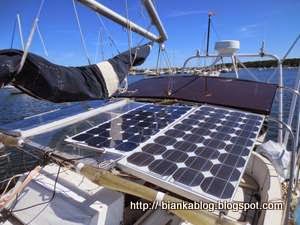 |
| Temporary cabin meter setup |
 |
| Original Kings LORAN mounted |
But, sipping a beer one day I looked at the space where the original Kings 8001 Loran unit used to reside and found that the waterproof junction box fit very nicely between the still installed Kings mounting bracket. AHA I thought the box would be perfect for the solar panel ammeter moving project. So it began.
First I decided where on the waterproof box I would mount the ammeter and marked it out:
Then using a hole saw I cut out a hole for the back of the meter to fit through:
It was not quite the right size so out came the trusty Dremel Tool and using a cutting drill I was able to enlarge it slightly to the proper size. Once that was done I carefully removed the front panel of the meter to mark where the mounting holes would need to be drilled to secure the meter:
Once that was done I mounted the meter:
I used Anderson Powerpole connectors for most of the connections behind the panel in the junction box. This will allow for easy trouble shooting or changes in the future should I need to do so:
With the ammeter installed now I could easily see how many amps are heading into the 12 volt house bank and how I can improve on the amount of current by repositioning the movable Renogy 100 watt panel or repositioning the boom:
I also thought up another useful addition to this project that I will post about as soon as some parts arrive to implement it.




































.jpg)


